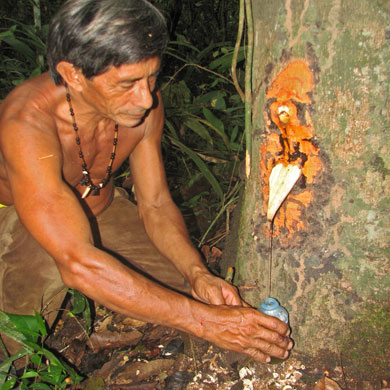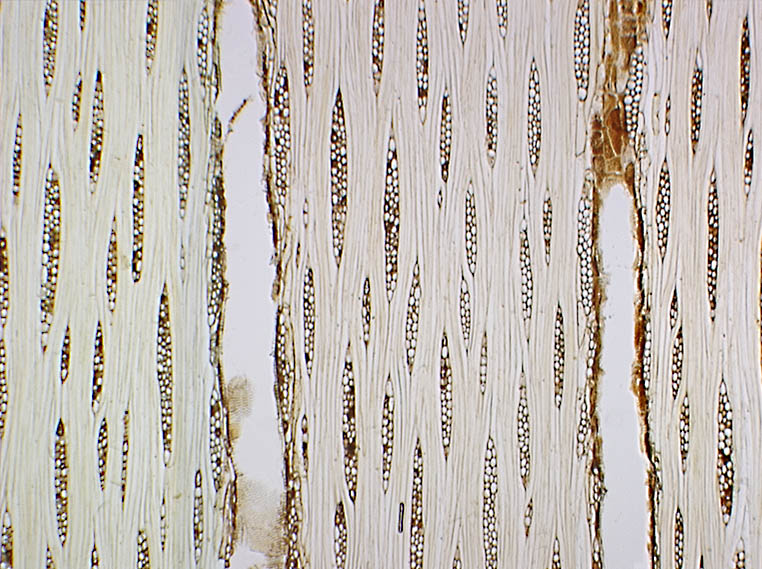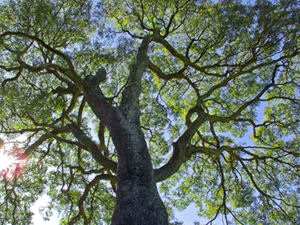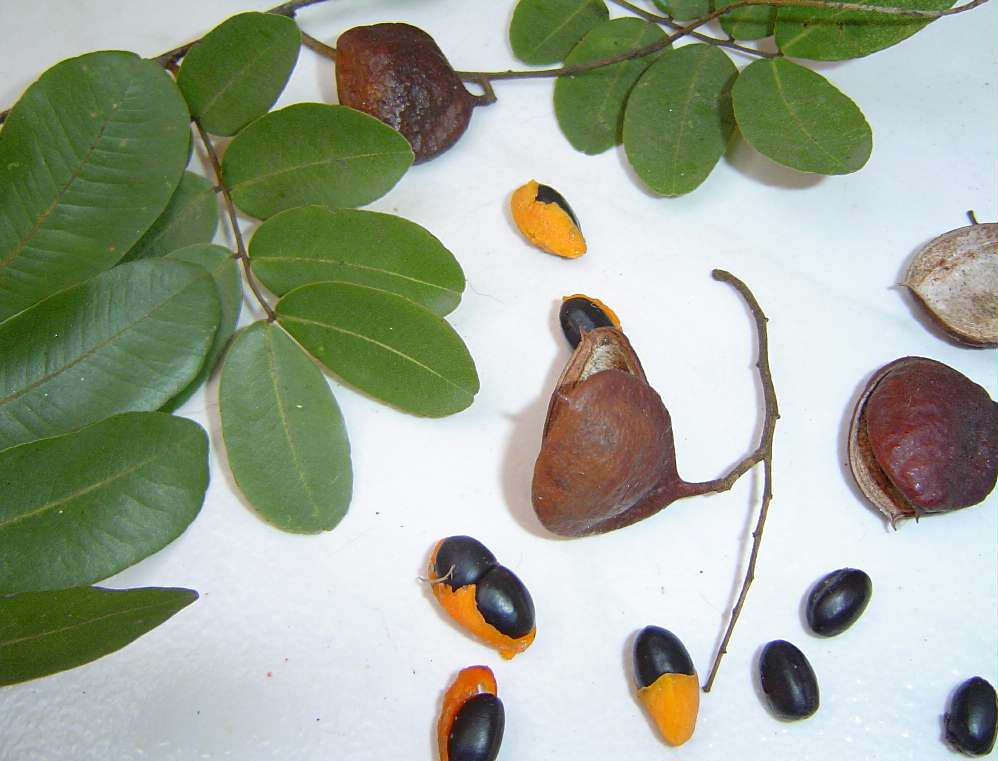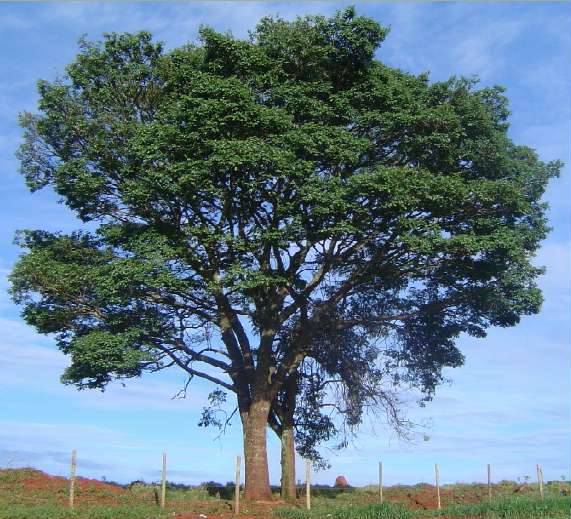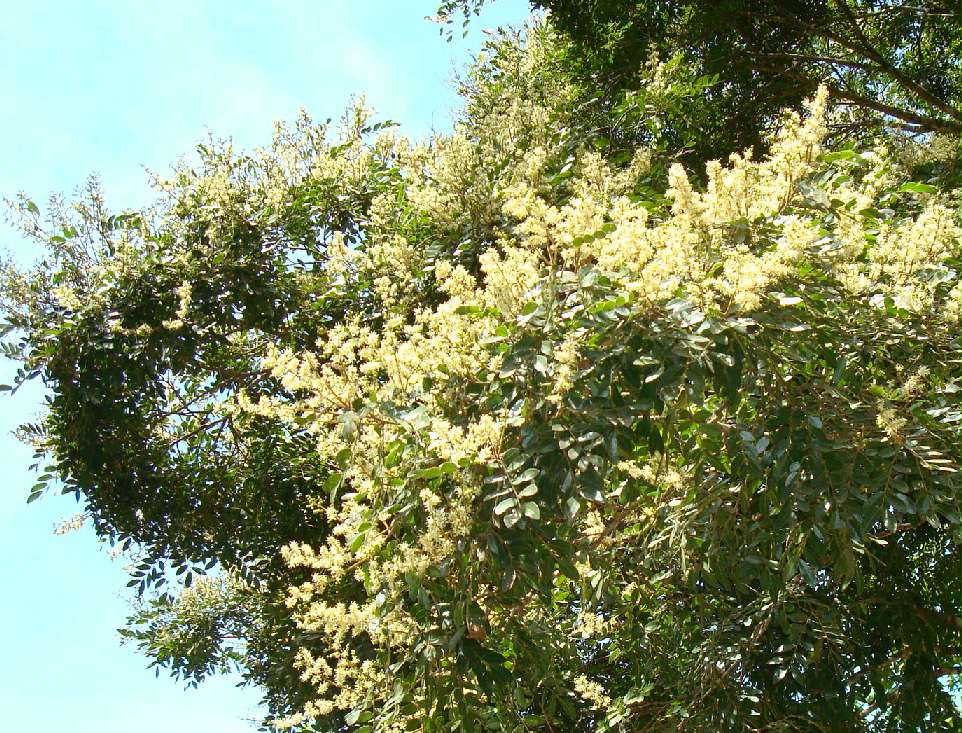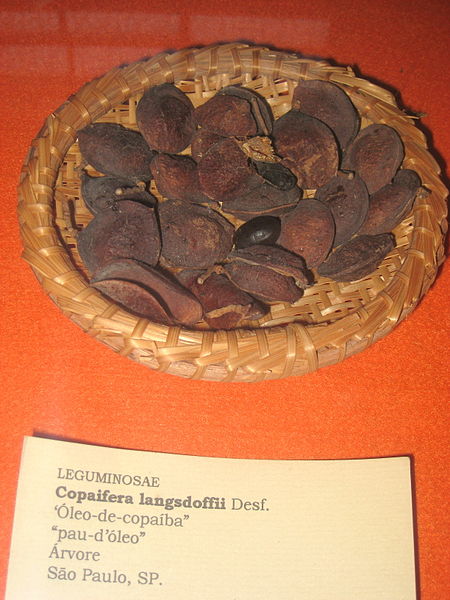Copaifera Langsdorfii
Yields
Copaiba is particularly interesting as a source of biodiesel, because of the high yield of 12,000 liters per hectare. The resin is tapped from standing trees, with an individual tree yielding 40 liters per year.
The hydrocarbons in Copaiba are terpenes, which are made by plants from isoprene commonly known as turpentine. Heated up, terpenes break down into methanol (CH3OH) and other simple compounds useful for fuel and as raw materials in the chemical industry.
Obtaining diesel by incising the trunk was first reported in England in 1625, in a work published by Purchas, "…a single tree is said to yield about 40 litres." (Grieve, 1931). Quoting nobel-laureate Calvin, Maugh says (1979), "Natives … drill a 5 centimeter hole into the 1-meter thick trunk and put a bung into it. Every 6 months or so, they remove the bung and collect 15 to 20 liters of the hydrocarbon.
Description
Evergreen tree to 35 meters tall, to 1 meter in diameter. In Argentina (Territorio de Misiones) it is 6-12 m tall. There is some question about the distinctness of the species. This species, called "Copaiba" in Brazil, is called "Cabismo" in Venezuela, a name applied in Darien Panama to what was identified by Duke (1972) as Copaifera officinalis, but has since been relegated to another species. Seedlings germinate well in dense shade. Bees are major visitors of the tree for pollen.
Distribution
Amazonian South America, ranging from Subtropical Dry to Wet through Tropical Dry to Wet Forest Life Zones, this Copaiba tolerates annual temperature of 20 to 27°C (with no frost), and pH of 4.5 to 7.5. Early USDA publications suggest that most Copaiba comes from regions with annual precipitation of 3500 mm or more and annual temperature 27°C. Copaifera Langsdorfii are thirsty, they need a lot of water to grow, so they are ideally suited for areas with tropical temperatures and high rainfall.
Planting
Planting at a spacing of 3 x 1.5m, C. Langsdorfii showed high growth rate in height and stem diameter after 5 months.
Harvesting
A cross section of the trunk shows that the hydrocarbons collect in thin capillaries that may extend the full 30-meter height of the tree. A hole drilled into the tree collects hydrocarbons from capillaries ruptured by the drilling, so it may be possible to increase the yield by drilling additional holes. An acre of 100 mature trees might thus be able to produce 25 barrels of fuel per year, or one hectare at 62 barrels. The Brazilian government has already established experimental plantations. It is of interest chiefly as an example of the great diversity of materials produced by plants (Maugh, 1979).
Viability
USDA once reported per tree yields as high as 53 liters (14 gallons). A tree yields 53 liters of "diesel" and diesel sells for $1.00 per liter, it would pay labor costs to gather the material. Apparently this is not happening to any great extent. Back in 1938, the U.S. imported from Brazil nearly 100 tons worth only $30,000 then, 106 tons worth $34,000 in 1939, and 102 tons worth $36,000 in 1940.
Calvin (1980) reports yields of 40 liters of hydrocarbon per tree per year, which can be "used directly by a diesel-powered car." Calvin sent a sample to Mobil Corporation to obtain a cracking pattern. "It produces the same kind of mixture in general as the oil from the E. lathyris [mostly aromatics (50%), LPG (25%), and low-molecular-weight fuel gas (3 to 4%) and coke]."
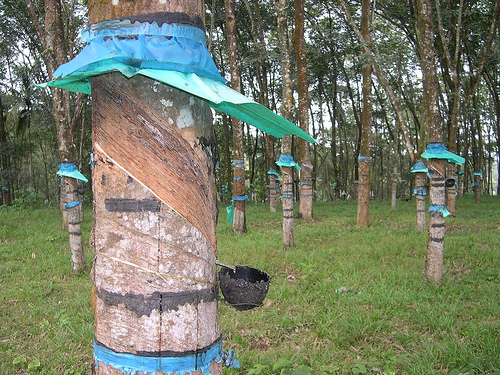
I know its a Rubber Plantation, but it gives you the idea.
Diesel Tree Project in Australia
Mike Jubow, a nursery wholesaler from Mackay, has begun importing seed from Brazil to plant diesel trees (copaifera langsdorfii).
Mr Jubow, who operates the Nunyara Wholesale Forestry Nursery and has been in the industry for 14 years, said he had heard about the trees from a colleague attending a forestry conference.
"I thought 'I've got to get seeds for this thing' and it's taken me three years to track them down."He sourced the seed from Brazil and says the first seedlings would be available in late January.
The recommended method of growing them is to plant 1,000 trees on a hectare of land, preferably in a tropical area, then test them for their vigour, growth and yield about three years later, which ordinarily would lead to culling about half of them.
About four to six years later they would be measured again before culling them down to between 250 and 350 of the best trees, which would be inter-bred and harvested for seed.
Mr Jubow said a large mature tree would yield about 40 litres of diesel a year, which equated to about 12,000 litres per hectare of trees.
Energy Independence on the Local Scale
"It becomes astonishingly viable for a farmer to have a piece of his most productive land to get the tree up and running and then he can be independent from the fuel companies for the rest of his life," he said.
Australian Farmers hope the trees will provide a consistent and cheap fuel source for their machines; essentially making them independent producers and lessening the shock of oil prices on the bottom line.
The trees are known to produce fuel for 70 years.
The fuel cannot be stored for more than 3 months, if it is left too long, it thickens into Copaiba oil, which is used in alternative medicines and fetches around $100 a litre in the United States.
And at the end of the tree's life, it can be milled to produce a light brown timber favored by cabinet makers.
"There's nothing wasted on the tree," Mr Jubow said.
David DuByne is a consultant for companies entering Myanmar & agricultural commodities export broker for green coffee, honey, farm raised fish out of Myanmar. He can be reached at ddubyne (at) oilseedcrops [dot] org.

